617 Search Results for tell me about it
November 4, 2021
by Carole Zangari -
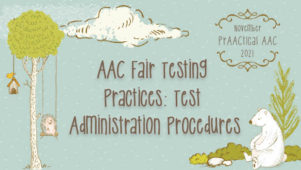
Without a thoughtful assessment plan in place, people who use AAC may be at a disadvantage when taking tests. Fatigue, excessive anxiety, comprehension difficulties, motor challenges, limited access to robust language, and other factors may make it difficult for them to demonstrate what they know. Today, we continue our series on AAC Fair Testing Practices with a discussion of test administration practices. In formal testing, any changes to testing procedures invalidate the use of normative data. If we modify the directions or response options provided to an AAC user, we can’t compare their scores to the scores of individuals who took the test without any modifications. That means we aren’t pouring through the tables at the back of the test manual to find age or grade equivalency scores. Still, we have to be thoughtful in when and how to make adjustments to testing practices. In this post, we consider two... [Read More...]
October 24, 2021
by Carole Zangari -
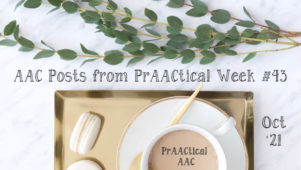
Happy Sunday, AAC friends. Here are some posts you may have missed. Monday – AAC Goal Writing with Lauren Enders: 5 Common Challenges Tuesday – AAC Link Up Wednesday – Video of the Week: Relationships and AAC Thursday – Growing AAC Professionals: AAC Awareness Month If you’re looking to make this an AAC-friendly Halloween week, check out this post from the archives. Go Away, Big Green Monster is a popular book this time of year. Check out these suggestions for using it to build AAC skills in this post by Maggie Judson and Jeanna Antrim. Halloween makes us think of bobbing for apples and enjoying candy apple treats. If you’re up for some reading about apples, this post from Karen Natoci has some ideas that you might enjoy. :::::::::::::::::::::::::::::::::::::::::::::::::::::::::::::::::::::::::::::::::::::::::::::::::::::::::::::::::::::::::::::::::::::::::::::::::::::::::::::::::::::::::::::::::::::: Looking for a few more posts to browse? We’ve got a few suggestions for you. PrAACtically Reading with Karen Natoci:... [Read More...]
October 18, 2021
by Carole Zangari -
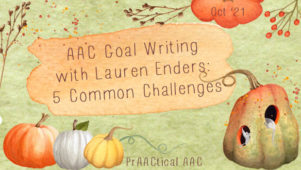
Goal writing is a challenging topic even for veteran AAC service providers. Today, we continue the AAC Goal Writing series guest authored by AAC and AT expert, Lauren Enders, who works as an AAC/AT Consultant for Bucks County Intermediate Unit in eastern Pennsylvania. A frequent presenter at local, regional, and national conferences, Lauren uses her knowledge to support families and professionals alike. In this post, she provides suggestions for addressing some of the most common challenges in writing AAC goals and objectives. ::::::::::::::::::::::::::::::::::::::::::::::::::::::::::::::::::::::::::::::::::::::::::::::: FIVE COMMON AAC GOAL WRITING CHALLENGES In the inaugural post of this series, you learned that if you feel intimidated by the process of writing goals and objectives for AAC learners, you are not alone. AAC goal writing can be intimidating. The good news is that with guidance, resources, tools, and practice, AAC goal writing gets easier. In this post, we’ll examine common AAC goal writing... [Read More...]
September 20, 2021
by Carole Zangari -
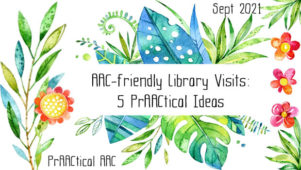
The community of AAC practitioners and families includes many people who have strong connections to their school or community libraries. In today’s post, we share some thoughts and resources on making library visits more accessible and engaging to those with AAC needs. Social narratives are a wonderful, evidence-based way to help AAC learners prepare for the experience of visiting the library. These work best when the pictures and text are customized to fit the specific library situation that the AAC learner will encounter. Here are some examples. Nicole Caldwell’s example of a social narrative Lancaster Public Library Social Narrative for Children Social Narrative for Teens Take a video tour of the library, like this one from Powell River Library. If your local library doesn’t have an online video tour, suggest that they create one or, if you’re feeling ambitious, create your own. Create a visual schedule or picture checklist for... [Read More...]
September 2, 2021
by Carole Zangari -
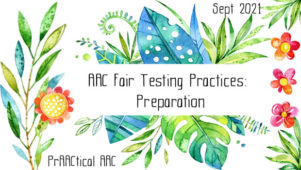
In an earlier post, we talked about the difficulties that people who use AAC experience when they have to participate in tests or other assessments for educational or therapeutic purposes. (You can see that post here.) One approach to addressing these challenges is for key stakeholders to come together and develop a set of guidelines that teachers, therapists, and others can use when they need to administer an assessment. Today, we’ll look at some of the guiding questions that teams can use to develop these Fair Testing Practices. The idea here is that AAC users, families, professionals, and other team members can come together to discuss a number of specific issues regarding preparation, materials, means of answering questions, etc. Later in the series, we’ll talk about ways to facilitate meaningful participation by individuals who use AAC but are still developing their communication and language skills. For the time being, though,... [Read More...]
August 23, 2021
by Carole Zangari -
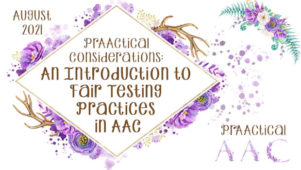
Why do students who use AAC have difficulty showing what they know when taking tests and quizzes? More than a decade ago, Lisa Proctor and I wrote about the unfair ways that students who use AAC are tested in the book Practically Speaking: Language, Literacy, and Academic Development for Students with AAC Needs that I co-edited with Gloria Soto. Later, I wrote about that on these pages, too, discussing how we set them up for failure in our current practices (see PrAACtically Unfair: Why People Who Use AAC Sometimes Fail at Tests). As I talk to educators, clinicians, families, and AAC users, it seems that little has changed, at least here in the US. AAC users are still routinely tested in ways that set them up for failure. We don’t test what a 4-year-old knows about animals by having them write about the subject. Why? Because they can’t write well... [Read More...]
August 2, 2021
by Carole Zangari -

Writing goals for AAC learners, whether they are beginning communicators or focusing on more advanced linguistic concepts, can be tricky and intimidating. Today, we introduce a new series authored by PrAACtical AAC friend and AAC/AT expert Lauren Enders to give us insight on the process and tips for developing strong goals and objectives. Throughout this series, Lauren shares her perspective developed from her years of experience in public schools and as a nationally recognized presenter. :::::::::::::::::::::::::::::::::::::::::::::::::::::::::::::::::::::::::::::::::::::::::::: Though it may be hard to believe, back-to-school is around the corner! As we get ready to head back into the classroom, now seems like the perfect time to launch a series exploring best practices to consider when writing IEPs for our AAC learners. The thought of crafting IEP goals and objectives for students who are learning to use AAC strikes fear into the hearts of many SLPs, special education teachers, and other school... [Read More...]
July 8, 2021
by Carole Zangari -
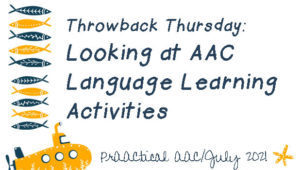
What are the language learning priorities for the AAC users in your life? Expanding vocabulary? Increasing sentence length and complexity? Using a greater range of communicative functions? Applying morphological markers? Given the heterogeneity of our AAC learners, it’s no surprise that the language goals we address are just as diverse. Today, we dig through the archives to highlight activities that can be used to target an array of language learning objectives. Browse through the list to see if you can find some that are of use in your AAC work. Concept Sorts Using Surveys to Support Language Learning Magic Moments with Tellagami New Word Teaching: A Look Inside Some PrAACtical Therapy Sessions Teaming Up to Build Communication with a Treat Cart: Part 1, Part 2 AACtual Therapy: Use Your Best Spud to Teach Vocabulary With Tanna Neufeld PrAACtical Supports for AAC Learners: AT Recipes for Success – Sensorimotor Activities AAC... [Read More...]
June 28, 2021
by Carole Zangari -

Do you know anyone who has access to AAC tools but doesn’t yet use them throughout the day? Keiran has a new AAC app that is well-populated with core vocabulary. Gabbie has had an SGD for a while but doesn’t use it as frequently as her team had hoped. Hudson is transitioning from PECS to an AAC device with more robust language. While different in many ways, each of these learners has a common need: frequent opportunities to learn about and use core vocabulary. To accomplish this, their SLPs, teachers, and families select a dozen or so core words and pay special attention to those each month. That allows them to highlight this small group of words using focused language stimulation, aided language input, and specific activities designed to teach or practice them. In previous years, we shared lists of some core words to help you do just that. ... [Read More...]
June 24, 2021
by Carole Zangari -

Looking to freshen up your library of books that include characters with disabilities? This updated list has a few that you may want to check out. The books in these lists vary in terms of their subject, target audience, and reading level. As with any book that you consider providing to children and youth, be sure to review it first to determine its appropriateness for the individual reader. Some of the books, particularly those for teens, have scenes that are intense and may contain mature content, and/or strong language. Note: If you have others that you would recommend, please reach out to us and we will update the list. Books Featuring Children & Youth with Disabilities AAC Dancing Daisies (2013) by Sara Pyszka Fur Cubs Present First Day of School (2010) by C. Lynne Luster How Katie Got a Voice (And A Cool New Nickname) (2012) by Pat Mervine Inside... [Read More...]









